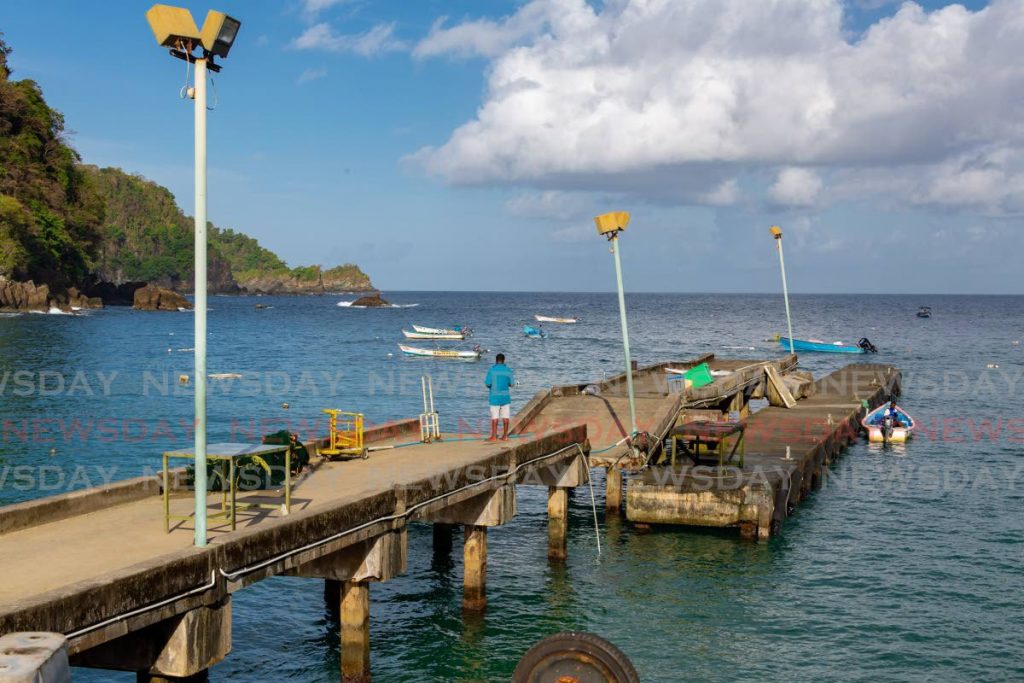THA commits to new Parlatuvier jetty

The National Infrastructure Development Company (Nidco) has received the go-ahead from the Tobago House of Assembly (THA) Executive Council as project managers to reconstruct the Parlatuvier jetty, although funding is yet to be identified.
THA Secretary of Infrastructure, Quarries and the Environment Kwesi Des Vignes announced this on Monday during a news conference hosted by the division to address the collapse of the jetty at the division’s conference room in Shaw Park. Des Vignes said he sympathised with the fishermen who have expressed frustration with the situation.
He said: “It troubles me.
“From a policy standpoint, I have a particular interest, as persons know, in the environment, the blue economy and the green economy as well, and many of the fishermen in Parlatuvier are my friends and I can say that without reservation. So I know the frustration that they face daily quite well, I am not unfamiliar with it.
"It’s a bit frustrating for me as well not being able to deliver on the project. However, we remain steadfast in our commitment to work with the fishermen and to resolve the issue.”
He said coastal work was extremely expensive work.
"As you are well aware, the THA only receives about $200 million in development allocation annually, and it means then that we’re faced with making extremely difficult decisions on a daily basis.”

He said because of this, in 2018, the THA, through the Division of Infrastructure, after getting permission from the Minister of Finance to borrow an initial US$15 million, engaged the Latin American Bank – CAF.
This sum, he said is primarily for the jetty at Little Tobago, Grange Bay and arresting coastal erosion at Milford Bay, Pigeon Point. He said unfortunately at that time, they were not able to convince the authorities about the Parlatuvier jetty, but owing to the new development, he has recently spoken to the principals, who said a supplemental arrangement could be looked at.
“The reality is, getting the Parlatuvier jetty fixed continues to be a priority. We are trying to allocate funding towards getting it done. But in the meantime, while the grass is growing, the cows cannot starve and quite literally, Parlatuvier is one of the main fishing jetties in Tobago. So it means that we have a duty to provide an interim measure to the fishermen.”
He said so far, Nidco has begun its due diligence and has submitted an initial proposal.
Delving into the proposal, senior technical co-ordinator at the division Abdullah Chadband said there were a lot of signs of failure on the jetty previously, as part of it had fallen before. He said the response now is no knee-jerk, as the division had been in talks with Nidco for the past two years.

“We’ve been looking at the project internally. We’ve been doing our value engine exercise, proposing things that we know would actually present some benefits. One of the things that we asked Nidco to consider in the development of their proposal was to include infrastructure for a fuel station on the jetty. We wanted to ensure that whenever the jetty goes up, the infrastructure, the piping etc, is already there.”
He said in the proposal, the division saw some additional things it wanted to include, after collaboration with the fisherfolk in the area.
In the short term, he said several measures were explored, and initial suggestions were narrowed down to two.
“We believe we may get some leeway with the EMA providing we show them that we have a long-term solution, which is the Nidco solution...to actually create a runway down into the ocean, possibly about 80 feet in. This would allow the fisherfolk to move with vehicles on something like that, created out of boulders, so that they would be able to get down to their catch, put it in their vehicles and go out.”
He said the division was looking into getting hexapods (concrete armours against waves) instead of using boulder, adding that the disadvantage with the latter, because it is a short term method, when it is time to be removed some would remain on the seabed unless it is dredged.
“With the hexapods, you just have to tie a strap around them and take them out. It's minimal – you don’t have anything left back on the seabed.”
He said the Certificate of Environmental Clearance (CEC) application is currently being prepared with the hope that EMA would treat the issue as an emergency and respond favourably.
Asked the price of the long-term solution, he said: "I don't want to put what the preliminary costs are, because it may prejudice any tender going forward but it is an alarming sum – that is one of the major drawbacks we usually get with things like these. Coastal engineering tends to be the most expensive of engineering fields, and typically a jetty the size that we want to put there pobably could cost you anywhere between $60-$100 million."
Officials at the division are expected to meet with the Parlatuvier fisherfolk later this week to discuss the plans.
On February 22, fishermen said part of the jetty had sunk ten feet and had separated from the landing by approximately five feet. They believe the damage was caused by rough seas. Last Thursday, they saw more of the unstable jetty had fallen into the sea, and they could not access it at all.
The day before, the THA Division of Food Production, Forestry and Fisheries in a press release said the jetty had been damaged, was unsafe and use of it was prohibited.

Comments
"THA commits to new Parlatuvier jetty"